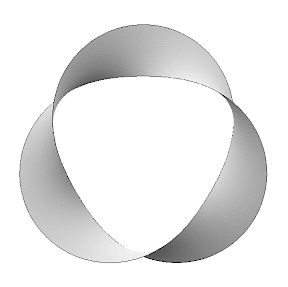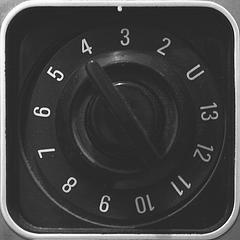As we consider ourselves in the flow of the day, we pause, once again, to consider identity. During the rush of the day we move through a thousand states. We flow from this to that as a result of our actions. Our many identities spring from the scenes we string together: the moment when we stop to shield our eyes from the sun; the quick turn of our heads when we think someone has called our name; the curse under our breath as the bus we’ve been waiting for arrives full and passes without stopping. They’re signifiers and contexts that circulate, they flow around us— around the things we do. They assign us a role within the never-ending series of stories that collect around us as we move through the world.
As we attempt to understand identity on the Network, we seem to crave a unified identity— a single container to hold all of our masks. And while we are beginning to transition from the static file to the real-time stream, we still want to draw a solid line around identity. The objects of the Network have been injected with time; we place the cursor here in the stream, a bread crumb to mark the spot, to provide reference for the next time we dip in. The artifacts of Internet identity are, of course, the outerworld of our innerworld— snapshots along the way.
In the book by the same name, there’s a poem entitled: “The Innerworld of the Outerworld of the Innerworld.” This phrase is a condensation of the style of Peter Handke’s early writing. We can plainly see the outerworld of the innerworld, these are the external artifacts of our internal stream of consciousness. But those objects of the outerworld have their own innerworld (a flux of time). Handke effects a change of perspective, a change of context— from the inside out to the outside in, and then to the inside of that outside. But it’s a poem with a different title in this volume that clarifies this complex perspective: “Changes during the Course of the Day.”
Changes during the Course of the Day
by Peter Handke
As long as I am still alone, I am still alone.
As long as I am still among acquaintances, I am still an acquaintance.
But as soon as I am among strangers—
As soon as I step out on the street— a pedestrian steps out on the street.
As soon as I enter the subway— a subway rider enters the subway
A soon as I enter the jewelry shop— a gentleman enters the jewelry shop.
As soon as I push the shopping cart through the supermarket— a customer pushes the cart through the supermarket.
As soon as I enter the department store— someone on a shopping spree enters the department store.
Then I walk past some children— and the the children see an adult walking past. Then I enter the off-limits zone— and the guards see a trespasser enter the off-limits zone. Then I see children running away from me in the off-limits zone— and I become a guard whom the children flee because they are unauthorized persons in an off-limits zone.
Then I sit in the waiting room as an applicant. Then I write my name on the back of the envelope as a sender. Then I fill out the lottery ticket as a winner.
As soon as I am asked how one gets to BLACK ROAD— I become someone who knows his way around town.
As soon as I see the incredible— I become a witness.
As soon as I enter the church— I become a layman.
As soon as I don’t ignore an accident— I become a busy-body.
As soon as I don’t know how to get to BLACK ROAD— I am again someone who doesn’t know his way to BLACK ROAD.
I have just consumed the meal— already I can say: We consumers!
I have just had something stolen from me— already I can say: We proprietors!
I have just placed the obituary— already I can say: We mourners!
I have just begun to contemplate the universe— already I can say: We human beings!
I read the novel in the mass publication— and become one among millions.
I don’t fulfill my duties toward the authorities— and am no longer a dutiful citizen of the state.
I don’t run away during the riot— and I’m an inciter of riots.
I look up from the novel I’m reading and observe the beauty opposite me— and we become two among millions.
Then someone does not leave the moving train— someone? — A traveler.
Then someone speaks without an accent— someone? — A native.
Then someone has a vis-à-vis— and becoma a vis-à-vis.
Then someone no longer only plays by himself— and becomes an opponent.
Then someone crawls out from under a thicket in the park and becomes a suspicious subject.
Then someone who is being discussed becomes an object of discussion.
Then someone is recognized on a photo— and becomes an X.
Then someone takes a walk in the country— someone? A wanderer.
And then the car makes a sudden stop in front of me— I become an obstacle.
Then I am seen by a figure in the dark— and become a figure in the dark.
And when I am then observed through binoculars— I am an object.
Then someone stumbles over me— and I become a body.
And when I am then stepped upon— I become something soft.
Then I am wrapped up in something— and become a content.
Then one notices that someone has run barefoot over the dirt road and that a right-hander has fired the shot and that someone whose blood group is O has lain there and that I, judging by the my shabby looks, must be a foreigner.
As soon as someone challenges me then— the one who’s been challenged doesn’t stop when challenged.
As soon as I am then far enough away from the observers— the object is nothing but a dot.
As soon as I, as an observer, challenge someone— I give the one who has been challenged quite a fright.
Then, finally, I meet an acquaintance— and a single person remains behind alone.
Then, finally, I am left aone— and a single person remains behind alone.
Then, finally, I sit down next to someone in the grass— and am finally someone else.
From The Innerworld of the Outerworld of the Innerworld by Peter Handke, translated by Michael Roloff
11 Comments



